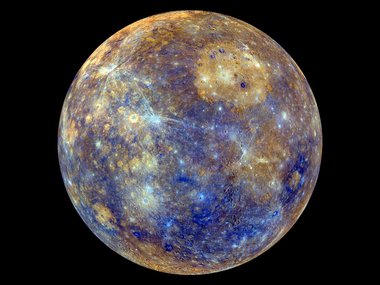Exoplanet Exposition
For most of human history, we could look up at the sky and identify a handful of planets: Mercury, Venus, Mars, Jupiter and Saturn. (The Moon and Sun counted for a while too, but that’s another story.) With the introduction of new technology—the telescope—astronomers could see further, and Uranus and Neptune were added to the list. (Pluto counted for a while too, but that’s yet another story.) Counting the Earth, we knew of eight planets ranging from small, cratered Mercury to giant Jupiter with its thick, swirling atmosphere.
The Copernican principle grew out of our ongoing census of the solar system. In its simplest form, it says Earth does not occupy a unique or privileged place in the universe. It’s often used today to help us understand the universe on its largest scales, but it’s worth applying the Copernican principle on smaller scales, too. For example, if an unspectacular star like the Sun can be orbited by eight planets, we should expect that other stars are capable of hosting their own diverse collections of worlds. That suggestion sounds simple enough, but it took hundreds of years and numerous technological advances to show us just how many other planets could be out there.
As it turned out, the universe would also insist that astronomers be willing to look for these worlds in the most unexpected places. The first planets found outside of our solar system—the class of objects that came to be called exoplanets—showed us just how alien these worlds could be.
Exoplanets have been discovered in a number of different ways. This 360-degree visual is color-coded to show how each exoplanet was identified. Use your mouse to move the screen to take a peek around the cosmos.
While studying a recently discovered pulsar called PSR 1257+12, astronomers Aleksander Wolszczan and Dale Frail noticed that the radio pulses were being shifted in time in a regular pattern. They published their explanation in 1992: two planets, both a few times the Earth’s mass, looping around the pulsar in orbits taking 66.54 and 98.21 days. The team identified a third planet in the system two years later, and it’s even closer to the pulsar, completing a lap in just 25.26 days. (Remember: Earth takes 365.25 days to complete its orbit.) Perhaps even more surprisingly, its mass is estimated to be only about twice that of the Moon!
Nearly 30 years later, this tiny planet remains the smallest exoplanet discovered. Most pulsars are strongly magnetized remnants of exploded stars—an unusual host for a collection of planets—so this pulsar itself might be a bit out of the ordinary, possibly forming from a merger of two white dwarfs. If the planets grew out of the debris of such a merger, it means they wouldn’t have to survive the sometimes violent stellar deaths that produce objects like white dwarfs and pulsars.
In 1995, astronomers Michael Mayor and Didier Queloz found a planet around a more familiar Sun-like star called 51 Pegasi. This exoplanet offered its own surprises: it’s a gas giant about half the mass of Jupiter that orbits its star in just 4.23 days, corresponding to a distance just 5% Earth’s distance from the Sun! So close to the star, the planet’s atmosphere could be heated to nearly 2,000°F, likely causing its outer layers to puff up, making the planet larger than Jupiter despite its lower mass. And although we can measure the length of this planet’s year in terms of Earth’s days, 51 Pegasi b has no days of its own. Its close proximity to its star results in tidal locking—the same effect that keeps the same side of the Moon pointed toward Earth—and so half of the planet experiences endless sunlight while the other is perpetually dark.

Science Museum astronomer Justin Bartel with the discoverer of the first exoplanet, whom he met at a 2016 conference in Poland.
As much as we’d like to recount the full history of exoplanet discoveries, it’s become nearly impossible to do so outside of a multi-volume encyclopedia. Three decades on from the discovery of the first two exoplanets, astronomers have accumulated a collection of over 5,000 distant worlds!
The exoplanets described here may seem startling compared to the familiar solar system planets but as the discoveries piled up, new exoplanet extremes came with them. We now know of exoplanets that orbit their star in just a few hours, and some with elongated comet-like orbits. We know of planets more massive than Jupiter, and one that may be as small as the Moon. We’ve identified exoplanets that could contain vast stores of compressed graphite and diamond, while others have atmospheres where molten glass or iron may rain from the clouds. On the permanent nighttime side of Kepler-13A b, the active ingredient in many sunscreens, titanium oxide, may fall as snow!
Despite the obvious differences, comparisons between exoplanets and the solar system’s population are inevitable. The universe throws us another challenge here because the most common size among known exoplanets falls somewhere between that of Earth and Neptune, a range where the solar system offers no direct comparisons. It seems likely Neptune or Uranus is the best model for what these middle-sized exoplanets are like, but our knowledge of these outermost solar system planets is limited, too. Each of the so-called ice giants received a brief flyby from the Voyager 2 spacecraft in the 1980s, and no spacecraft has visited since. This was part of the motivation for the Planetary Science and Astrobiology Decadal Survey’s recommendation to launch a Uranus Orbiter and Probe mission in the near future.
Ultimately, astronomers hope to identify an exoplanet that looks a lot like Earth. There are a few known exoplanets of the right size, and some orbit the right distance from their star to have temperate climates. To be a perfect match to our world, an exoplanet would need to have a similar atmosphere—no molten glass or iron rain, please!
Newer instruments like those on the James Webb Space Telescope (JWST) are expected to help us determine whether our planet has any twins in the galaxy. It wouldn’t hurt to find even more potential matches, so astronomers are constantly looking for more exoplanets using telescopes spread around the globe and in space. One ongoing mission, the Transiting Exoplanet Survey Satellite (TESS), has found over 200 confirmed exoplanets and has amassed more than 5,000 additional candidates awaiting further study. Perhaps a truly Earth-like world is already in the data, waiting to be discovered.


